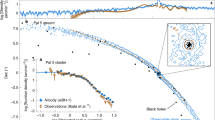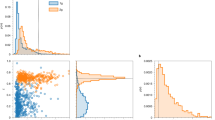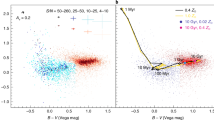Abstract
Globular star clusters contain thousands to millions of old stars packed within a region only tens of light years across. Their high stellar densities make it very probable that their member stars will interact or collide. There has accordingly been considerable debate about whether black holes should exist in these star clusters1,2,3. Some theoretical work suggests that dynamical processes in the densest inner regions of globular clusters may lead to the formation of black holes of ∼1,000 solar masses3. Other numerical simulations instead predict that stellar interactions will eject most or all of the black holes that form in globular clusters1,2. Here we report the X-ray signature of an accreting black hole in a globular cluster associated with the giant elliptical galaxy NGC 4472 (in the Virgo cluster). This object has an X-ray luminosity of about 4 × 1039 erg s-1, which rules out any object other than a black hole in such an old stellar population. The X-ray luminosity varies by a factor of seven in a few hours, which excludes the possibility that the object is several neutron stars superposed.
This is a preview of subscription content, access via your institution
Access options
Subscribe to this journal
Receive 51 print issues and online access
$199.00 per year
only $3.90 per issue
Buy this article
- Purchase on Springer Link
- Instant access to full article PDF
Prices may be subject to local taxes which are calculated during checkout

Similar content being viewed by others
References
Kulkarni, S. R., Hut, P. & McMillan, S. Stellar black holes in globular clusters. Nature 364, 421–423 (1993)
Sigurdsson, S. & Hernquist, L. Primordial black holes in globular clusters. Nature 364, 423–425 (1993)
Miller, M. C. & Hamilton, D. P. Production of intermediate-mass black holes in globular clusters. Mon. Not. R. Astron. Soc. 330, 232–240 (2002)
Rhode, K. L. & Zepf, S. E. The globular cluster system in the outer regions of NGC 4472. Astron. J. 121, 210–224 (2001)
Smits, M., Maccarone, T. J., Kundu, A. & Zepf, S. E. The globular cluster mass/low mass X-ray binary correlation: implications for kick velocity distributions from supernovae. Astron. Astrophys. 458, 477–484 (2006)
Colbert, E. J. M. & Ptak, A. F. A catalog of candidate intermediate-luminosity X-ray objects. Astrophys. J. Suppl. Ser. 143, 25–45 (2002)
Mushotzky, R. F., Cowie, L. L., Barger, A. J. & Arnaud, K. A. Resolving the extragalactic hard X-ray background. Nature 404, 459–464 (2000)
Williams, R. J., Pogge, R. W. & Mathur, S. Narrow-line Seyfert 1 galaxies from the Sloan Digital Sky Survey early data release. Astron. J. 124, 3042–3049 (2002)
Maccacaro, T., Gioia, I. M., Wolter, A., Zamorani, G. & Stocke, J. T. The X-ray spectra of the extragalactic sources in the Einstein extended medium sensitivity survey. Astrophys. J. 326, 680–690 (1988)
Angelini, L., Loewenstein, M. & Mushotzky, R. F. The X-ray globular cluster population in NGC 1399. Astrophys. J. 557, L35–L38 (2001)
Kundu, A., Maccarone, T. J. & Zepf, S. E. The low-mass X-ray binary-globular cluster connection in NGC 4472. Astrophys. J. 574, L5–L9 (2002)
Maccarone, T. J., Kundu, A. & Zepf, S. E. The low-mass X-ray binary-globular cluster connection. II. NGC 4472 X-ray source properties and source catalogs. Astrophys. J. 586, 814–825 (2003)
Oosterbroek, T. et al. Spectral and timing behaviour of GS 2023+338. Astron. Astrophys. 321, 776–790 (1997)
Lee, J. C. et al. High-resolution Chandra HETGS and Rossi X-Ray Timing Explorer observations of GRS 1915+105: A hot disk atmosphere and cold gas enriched in iron and silicon. Astrophys. J. 567, 1102–1111 (2002)
Kalogera, V., King, A. R. & Rasio, F. A. Could black hole X-ray binaries be detected in globular clusters?. Astrophys. J. 601, L171–L174 (2004)
Abramowicz, M. A., Czerny, B., Lasota, J. P. & Szuszkiewicz, E. Slim accretion discs. Astrophys. J. 332, 646–658 (1988)
Mukai, K., Pence, W. D., Snowden, S. L. & Kuntz, K. D. Chandra observation of luminous and ultraluminous X-ray binaries in M101. Astrophys. J. 582, 184–189 (2003)
King, A. R. & Pounds, K. A. Black hole winds. Mon. Not. R. Astron. Soc. 345, 657–659 (2003)
Zycki, P., Done, C. & Smith, D. A. The 1989 May outburst of the soft X-ray transient GS 2023+338 (V404 Cyg). Mon. Not. R. Astron. Soc. 309, 561–575 (1999)
Liu, Q. Z., van Paradijs, J. & van den Heuvel, E. P. J. A catalogue of high mass X-ray binaries. Astron. Astrophys. Suppl. 147, 25–49 (2000)
Truss, M. & Done, C. The decline and fall of GRS 1915+105: the end is nigh? Mon. Not. R. Astron. Soc. 368, L25–L29 (2006)
Portegies Zwart, S. F., Dewi, J. & Maccarone, T. Intermediate mass black holes in accreting binaries: formation, evolution and observational appearance. Mon. Not. R. Astron. Soc. 355, 413–423 (2004)
Blecha, L. et al. Close binary interactions of intermediate-mass black holes: Possible ultraluminous X-ray sources? Astrophys. J. 642, 427–437 (2006)
Hopman, C., Portegies Zwart, S. & Alexander, T. Ultraluminous X-ray sources as intermediate-mass black holes fed by tidally captured stars. Astrophys. J. 604, L101–L104 (2004)
Madhusudhan, N. et al. Models of ultraluminous X-ray sources with intermediate-mass black holes. Astrophys. J. 640, 918–922 (2006)
Patruno, A., Colpi, M., Faulkner, A. & Possenti, A. Radio pulsars around intermediate-mass black holes in superstellar clusters. Mon. Not. R. Astron. Soc. 364, 344–352 (2005)
Acknowledgements
K.L.R. is an NSF Astronomy and Astrophysics Postdoctoral Fellow. We thank E. Koerding, T. Dwelly, S. Jester, J. Salzer and G. Bergond for useful communications.
Author information
Authors and Affiliations
Corresponding author
Ethics declarations
Competing interests
Reprints and permissions information is available at www.nature.com/reprints. The authors declare no competing financial interests.
Rights and permissions
About this article
Cite this article
Maccarone, T., Kundu, A., Zepf, S. et al. A black hole in a globular cluster. Nature 445, 183–185 (2007). https://doi.org/10.1038/nature05434
Received:
Accepted:
Published:
Issue Date:
DOI: https://doi.org/10.1038/nature05434
This article is cited by
-
The nanohertz stochastic gravitational wave background from cosmic string loops and the abundant high redshift massive galaxies
Science China Physics, Mechanics & Astronomy (2023)
-
High-resolution imaging for advances in astronomy
Journal of Optics (2021)
-
Tidal Disruptions of White Dwarfs: Theoretical Models and Observational Prospects
Space Science Reviews (2020)
-
A new hybrid technique for modeling dense star clusters
Computational Astrophysics and Cosmology (2018)
-
An intermediate-mass black hole in the centre of the globular cluster 47 Tucanae
Nature (2017)
Comments
By submitting a comment you agree to abide by our Terms and Community Guidelines. If you find something abusive or that does not comply with our terms or guidelines please flag it as inappropriate.



